| [Down Spanish] |
Antonius Leeuwenhoekius Delphis Natus MDCXXXII
|
IMAGES
|
Van Leeuwenhoek´s scientific life
Introduction The purpose of this essay is, throwing light on some of van
Leeuwenhoeks´s less well-known experiments and observations and to provide
a short outline of the life and times of "the father of microbiology and
cellbiology" Antonie van Leeuwenhoek. A selection from the original
etchings has been made and is presented on this site. Religion and Science Throughout the centuries, discoveries have been made either to the
honour and glory of God,to enhance military power, to the benefit of trade
or both. Most of the scientists who laid the basis for the scientific age,
including Boyle, Copernicus, Galileo, Keppler, van Leeuwenhoek,
Huygens and Newton, believed in a personal God who revealed Himself in
the Scriptures and answered prayers. In many cases however, discoveries were neglected, denied or even put a
ban upon them by the clergy. In the year 399 A.D., Socrates (born ±
470 B.C.) was charged by three fellow citizens of corrupting the minds of
the youth, and of worshiping gods other than those of the city of Athens.
He was judged guilty and sentenced to death by hemlock. Galilei
Gallileo was summoned to Rome in 1633, being vehemently suspected of
heresy and he had to abjure the principles of Copernicus, kneeling in
front of members of the Inquisition. Though, Renaissance could not stop the development of new scientific ideas. Dogmatic principles could not check anymore the progress of scientific curiosity in the minds of human beings. Interestingly enough this should remind us to the situation in the prosperous Islamitic world of the past : Already Islamitic philosophers (Avicenna,Alhazes, Hunayn ibn Ishaq, Rhazes) and the physician and philosopher Ibn an Nafis (1210-1288 AD) in Damascus, succeeded in finding that the lungcirculation was a closed system (see the images below).
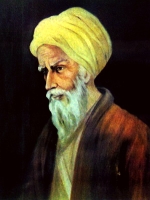 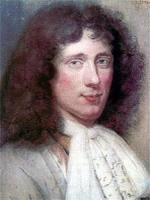 --------- Alhazen (965-ca.1039) - Christiaan Huygens (1629-1695) [Compare: Oevres completes de Chr.Huygens. Royal Holland Society of Sciences and Humanities. Bibliographical notes on the Oeuvres Complètes (1888-1950)] Abu Ali Hasan Ibn al-Haitham was one of the most eminent physicists, whose contributions to optics and the scientific methods are outstanding. Alhazen has had a profound influence on physical sciences in general, and on optics in particular. His influence can be traced in the works of great mathematicians like Keppler, Snell, Beeckman (!), Harriot, Huygens (!) and Descartes. Known in the West as Alhazen, Ibn aI-Hautham was born in 965 A. D. in Basrah, and was educated in Basrah and Baghdad. In his writing, one can see a clear development of the scientific methods as developed and applied by the Muslims and comprising the systematic observation of physical phenomena and their linking together into a scientific theory. This was a major breakthrough in scientific methodology, as distinct from guess and gesture, and placed scientific pursuits on a sound foundation comprising systematic relationship between observation, hypothesis and verification. Alhazen is the first to show how an image is formed on the eye, using the camera obscura as an analog. His greatest work was Kittab Al Manadir or Opticae Thesaurus Alhazani. This seven volume treatise on optics Kitab al-Manazir (written from 1015 to 1021) is possibly the earliest work to use the current scientific method. The ancient Greeks believed that truth was determined by the logic and beauty of reasoning; experiment was used as a demonstration. Alhazen used the results of experiments to test theories. The "emission" theory of light had been supported by Euclid and Ptolemy. This theory postulated that sight worked by the eye emitting light. The second or "intromission" theory, supported by Aristotle had light entering the eye. Alhazen performed experiments to determine that the "intromission" theory was scientifically correct. So let us keep in mind that the early Arabic scientists were the direct pioneers of the European Renaissance. And it were many of them who brought to us the findings of the ancient Greeks (Aristotle, Plato and Galenus) in a time that religious dogma´s and scientific interpretations were absolutely independant from each other [REF:67]. Renaissance In Western Europe the Scientific Revolution (1450-1750) [REF: 86] almost parallels the Renaissance. In particular the XVIIth century was the Age of Reason, a time of absolute monarchy, and the Age of Enlightenment. As the Renaissance flourished (from Macchiavelli and Leonardo Da Vinci,-Italy-, Newton - up to Huygens and van Leeuwenhoek in the Netherlands-) the scientific way of thinking changed drastically and influenced worldhistory profoundly. People of all social layers became more curious than ever before and started to ask independant questions [REF: 59] that could not (and would not) be answered by religious authorities [REF: 59, 60, 61]. According to Thomas Kuhn (1922-1996)[REF:74] the pre-paradigmatic phase of the natural sciences ended during Renaissance. In the XVIIth century, Antoni van Leeuwenhoek, the last amateur-scientist of the Renaissance, peered through a simple construction of lenses and screws and observed "animalcules" dancing through a drop of water [Animalcules: tiny beasties living all around us]. This was the first step toward recognition that microbes were the cause of infectious disease. Ever since this discovery, humankind has been fascinated with the microscopic world. To day,given once a decade by the Science Division of the Royal Netherlands Academy of Arts and Sciences [REF:56], a prestigious Leeuwenhoek Medal is awarded for outstanding contributions to the study of microbiology.
Since van Leeuwenhoek´s discoveries, we humans realized that our world is teeming with science-fictionlike tiny little monsters beyond our eyesight. Moreover, through the ages it became clear that distinction between bacteria, plants and animals could not easily be applied. And as the theory of evolution (Charles Darwin 1809-1882), became accepted, the study of living organisms through the microscope became much more important.[REF: 90]. Referring to Antonie van Leeuwenhoek as the first human being observing life through the microscope is a historical fact, though saying he was the inventor of this "magnifying glass" is a misconception. Probably, one of the first who abusively mentioned van Leeuwenhoek as the "inventor of the microscope" was the Dutch political leader and historian mr. G. Groen van Prinsterer in 1852 [REF:38]. Brought up to business van Leeuwenhoek started as a merchant. Experts disagree when he became interested in microscopy. In this field he was "the untrained layman" and was not a teacher (see hereafter, Short Biography). In some biographies van Leeuwenhoek is described as "the janitor from Delft" but the term "janitor" is misleading. In Delft he was the owner of a fancy-wool shop and certainly used magnifying glasses to investigate the quality of textile. Further,he was a wine assayer, a city official and a surveyor in Delft. Antonie van Leeuwenhoek received only an elementary education and spoke only Dutch. However,in his works he frequently used official medical terms in latin. From his works it can be concluded that van Leeuwenhoek was acquaint himself with the scientific theories of his contemperaries (for instance: Hooke, Newton, Leibnitz, Boerhave, Huygens, Stevin, Harvey, Swammerdam). Though not being a professional scientist in the true meaning, his discoveries were not at all neglected as were suggested by some. On the contrary, the famous Herman Boerhave (1668-1738) himself mentioned van Leeuwenhoeks observations about the muscles and the semen in his works (see also Missive to Boerhave). These (posthume) works were translated in all European languages including Arabic. BOERHAVE about van LEEUWENHOEK´s observations (Posthume edition by Johannes Grysius, 1745:SPIEREN-MUSCLES, MANNELYKEZAADS-SEMEN)
In 1839, nearley two centuries after this discovery cells were finally
ackowledged as the ubiquitous units of life by the Germans Matthias
Jacob Schleiden (1804-1881) and Theodor Swannn
(1810-1882).
Antonie van leeuwenhoek had a sanitary attitude, warned about filthy
water in the city-canals and probably disliked smoking:
TOP The Impact An analysis of the history of technology shows that technological change is exponential, contrary to the common-sense "intuitive linear" view. However, it lasted almost 200 years until the findings of van Leeuwenhoek could be improved with more sophisticated instruments. Antonie van Leeuwenhoek, who lived in a time of discoveries without
advanced chemistry, medical science or sophisticated technology, was an
accurate observer. He tried to interprete his observations, without being
dependant on the limited or erroneous ideas of his contemporaries, whether
they were prominent scientists or common people. And he did not feel
ashamed to study delicate matters such as the principles of
reproduction. The discoveries made by van Leeuwenhoek did not end the believe in
the
Spontaneous Generation Theory : To some
scientists (Needham 1745) it only served to enhance their believe in the
Spontaneous Generation Theory [REF:48]-[REF:42].
Already from the very first moment Antonie van Leeuwenhoek sent his
letters to the Royal Society in London, numerous articles are published
since about Antonie van Leeuwenhoek and his works. According to some [REF:2],
the genius of van Leeuwenhoek is, probably, the best thing that happened
to mankind. His discoveries helped us make the world a better place to
live in. The impact of the works of the "Father of
Experimental Biology and Microbiology" to the scientific world of his time
is difficult to estimate, but it was a significant breakthrough to
stimulate a new wave of research. People became aware of another world
crowded with innumerable tiny living creatures. [Click on this image for a guided art history tour through this painting.] 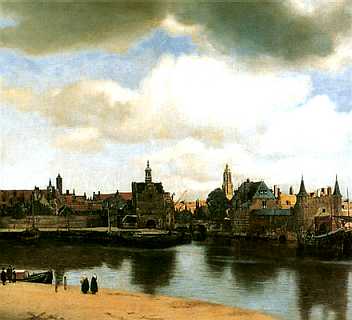 Doctors and apothecaries in The Netherlands would collect objects in the naturalia category as well as scientific instruments such as microscopes, to assist their studies. Van Leeuwenhoek took a keen interest in new ideas from scientists both in his own country and abroad, and exchanged objects and information with other collectors as can be read in his works. To day, we can see the pathogens, which are invisible to naked eyes, with the vision invaluable gifted to us by van Leeuwenhoek and can fight against them. With future technology, we will be able to hopefully sort out and solve many other health problems, as well as environmental problems like pollution. The latest researches in DNA replication and unveiling of the genetic code are all thanks to that brilliant vision, first striking the eyes of the genius Antonie van Leeuwenhoek. TOP The approach In many publications the assumption is made that
Leeuwenhoek´s fascination for microscopy was inspired with cloth-trade. On
the other hand, it is told that after reading the book of Robert
Hooke, Micrographia (1665), he became
interested in microscopes. Already as a young and curious boy he might
become interested in the new and popular branch of science, natural
history, just like youngsters nowadays are intrigued by ICT and computers.
The best way to describe the works of Antonie van Leeuwenhoek is as follows: He used, by nature, an inductive approach (like Harvey). He started (somewhat arbitrary) with observations and measures, began to detect patterns and regularities, he sometimes formulated a hypothesis which he tried to verify, rather than formulating a solid theory. Though not always using a systematic approach, Antonie van Leeuwenhoek is credited for his lifelong and accurate attempts to quantify his observations and make it public. In his works two basic principles can be seen: In the beginning van Leeuwenhoek was a follower of the
socalled dogma of the globulists : Every material (alife or dead)
is build up of globules ; so bloodcells and yeastcells should consist of a
unity of 6 globules. In finding "nothing but the truth" Antonie van
Leeuwenhoek admitted chivalrously when he was wrong or made
mis-interpretations. Parasitoidism, Polyembryony,
Pharmacological- and other experiments. The first pharmacological experiments on nutmeg from the Moluccas (the most important trade of the Dutch V.O.C) containing the volatile oil, myristicine a psychoactive toxin, were performed by van Leeuwenhoek, around 1676. He frequently observed peppers in water, under the erroneous assumption that it had microscopic "spikes" to produce its effect on the tongue. Toxicological interest in nutmeg is of long standing. As early as 1676, Van Leeuwenhoek noticed that a volatile constituent of nutmeg killed or repelled mites. Contamination Van leeuwenhoek, [though not yet familiar with the useful characteristics of the microflora in the tractus digestivus], mentioned the phenomenon of contamination. After observing numerous little animals in pond-water, van Leeuwenhoek himself speculated about the following in a letter to the Royal Society (Delft 28th june 1715, page 68, Dutch edition) :
Notwithstanding the fact that this is clearly a proof of common sense, nobody seriously payed attention to this remark, at that time ! Dominantion of a phenotypic trait in
rabbits. Cryptobiotic animals were documented by Anton van Leeuwenhoek (1702) , observing tiny life forms in sediment collected from rooftops. He dried the "animalcules" to preserve them, and when he later added water he saw the creatures (probably Rotifers) begin to move around [REF:85]. Anhydrobiosis : In 1702, Van Leeuwenhoek was the first to describe the phenomenon of anhydrobiosis in a species of bdelloid rotifer, Philodina roseola [REF:84]. He discovered for the first time that living cells are
composed of 80% water. Antonie van Leeuwenhoek was the first to use the
technique of microdissections on insects
and "obtained results which are remarkable even by modern standards"
[REF:41]. Conjugation. Lucky enough for the world,
he was not at all "influenced" by the usual academic theories of his days.
Though not a professional scientist he had the right attitude: Only after
critical verifying and repeating his observations he described his
findings. Some of his observations are only now coming to light. Van
Leeuwenhoek also may be credited with the establishment of a pioneering
example of forensic microscopy [REF:4]. Van Leeuwenhoek examined
everything, ranging from samples of about 200 biological species to
mineral objects and crystals; [he even experimented with the compound
of gunpowder and advised a chief-commander of the French army to shorten
the barrel of a gun "from 18 feet to 14 feet" in order to reach maximum
effect]. Protozia,
Bacteria and Spermcells. Leeuwenhoek made accidental
discoveries: tiny organisms, known today as protozoa, bacteria and
spermcells. But the student Johan ("Louis") Ham ( Ham was elected as a
Lordmayor of the city of Arnhem) was the first who discovered these
"germs". Van Leeuwenhoek has never asserted that "human
sperm is abundant of little infants" and he could become
angry if others tried to mis-interpret his findings. He concluded (a
novelty for his time) that fertilization occurred when the spermatozoa
penetrated the egg. Engraving of the "New Double Compound Microscope ", constructed and improved by Mr.John Cuff (± 1750), see Henry Baker [REF 80] and [The Gemmary Scientific Instruments].
However, van Leeuwenhoek was the first to see life under his microscope (with one simple spherical lens of suberb quality). In 1676 or earlier (NOT JUST 1683 when he described bateria in the plaque !)van Leeuwenhoek observed living things in pepper-water and wrote this discovery in a letter (9 oct. 1676) to Henry Oldenburg,(ca. 1620 - 1677) the first editor of the Royal Society’s journal Philosophical Transactions, (see hereafter) and intentionally underestimated the total account. He called them ‘animalicula’, what we now call Protozoa from the greek “first animals”. The arguments of Aristotle, and others about the Generatio Spontane were muted by the observations of Antoni van Leeuwenhoek. The first serious attack on the idea of spontaneous generation was made in 1668 by Francesco Redi, an Italian physician and poet. A Critical remark on the work of contempararies. Sometimes, to Antonie van Leeuwenhoek it was not unpleasant to criticize the work of other microscopists of his time. On following passage (Missive 57, 6 aug. 1687 to the Royal Society, pp 90) he was " not amused" by the work of a certain Johannes Fransiscus Griendelio, saying:
" People has told me and spoken highly about a certain book, dealing with microscopical observations, containing exceptionally magnified illustrations, a book that was put up for auction at the Frankfurtian fair. I was very eager to buy this book, hoping I could learn something. However, as soon as I had this book, named Micrographia Nova, edited by Mr. Joh.Fransisco Griendelio[REF: 89] , I saw that it was of no value : because the little creatures depicted in that book, such as the Louse , the Flea, the Ant etc. were large enough indeed, but they were drawn very imperfect and deformed. It do not know whether this is because the lack of qualified magnifying glasses, or it is due to the poor designer." The first reaction Van Leeuwenhoeks discovery of bacteria was not
immediately accepted by scientists.
Van leeuwenhoek refers to a letter he wrote to the Royal Society (1675) in which he says:
THANKS: However, fourty years later
Antonie van Leeuwenhoek, describing Barley in his Letter of June 12, 1716
(directed to "Cinck, Narrez, Rega and others") gives thanks for receiving
a golden purse and a commemorative silver medal for his work, writing as
follows :
NOTE: |

The Janssen microscope-tube about 1595.
(Father Hans and
son Zaccharias Janssen).Hans sometimes is named Hans Martens.
Its
magnification was up to 20X and it is the forerunner of the compound
microscope
and of the telescope.
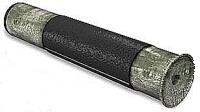 
|
Below: Van Leeuwenhoek Simple Microscope design type I (1670) in vertical position [32].
|
The quality
of van Leeuwenhoek´s so-called "primitive microscope" (design type I) was
far superior to all other microscopial designs for over 170 years. |
|
Microscope type II:"the AALKIJKER" (Eelwatcher or Fishglass) made of brass [35] The etching of the microscope "The Aalkijker or Fishglass " (design type II, 1688-1689) was first published in "Brieven pag.306, Cornelis Boutesteyn,Boekverkoper ´t Rapenburg,1688,Leyden.Ist Edition. Holland". Christian Huygens (1629-1695) also made a drawing of this microscope. This instrument was used by van Leeuwenhoek in studying bloodcirculation of "The EEL" in a glass-tube at the right (W-Q).The diameter of the lens of the Aalkijker micriscope has been estimated as follows: 1.8mm towards the objectside and 1.2 mm towards eyeside, according to the biohistorician Abraham Schierbeek (1887-1974) [REF:82].
|
Image of "The Eelwatcher microscope". This image is protected.
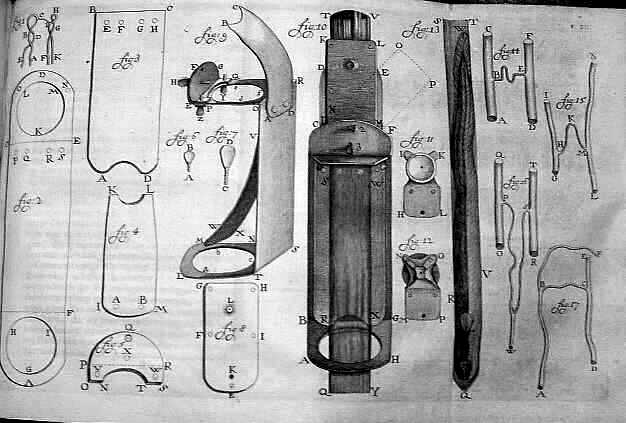
See a model of this design on the following link:Virtual Museum |
Drawing of van Leeuwenhoek´s microscopes by Henry Baker (1756),REF
80.
[Some coral species and dimensions in micrometers]
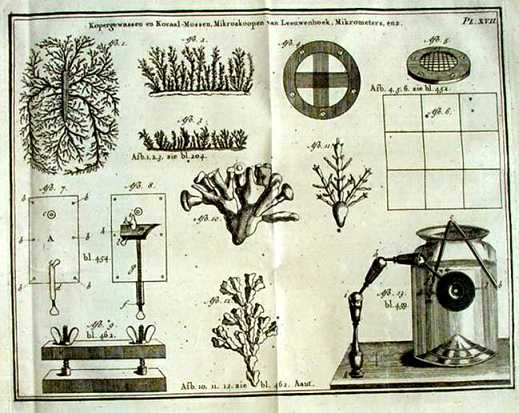 |
| Design of a microscope
adapted for use with a Camera Obscura (1871) to make photomicrographs The first published illustration of a camera is in a book from 1545, by the Dutch mathematician and astronomer Gemma Frisius (Dokkum 1508- Leuven 1555). |
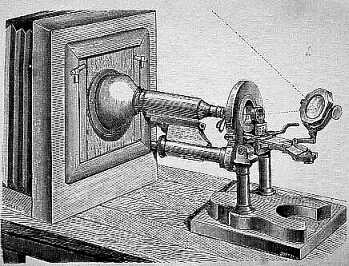 |
| Below: Carl Zeiss Jena
Laboratory compound monocular microscope This instrument has Diaphragm and Köhler's objective [model about 1930] Carl Zeiss signed :223693. The van Leeuwenhoek volumes. |
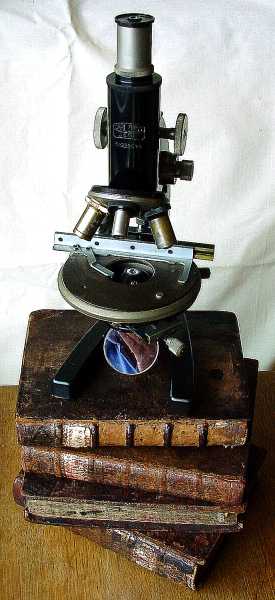 |
| First issues of the complete set of Leeuwenhoek's letters in their first appearance in the original Dutch. |
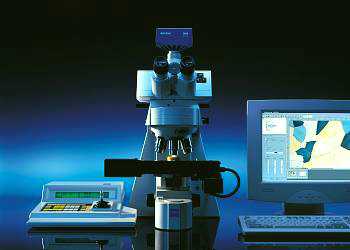 |
|
Sophisticated modern Zeiss binocular microscope (design 2002). Connected to a computer to produce digitalized images. |
TOP
Short BiographyIt is mentioned that Neeltje van Hogenhouck and Sebastiaen Cornelisz.
van den Berch or van den Bergh ("veertig-raad" and "schepen" in Delft)
became the great-grandparents of Antoni van Leeuwenhoek (Thonius
Philipsz)
[REF:44]. The name of at least one sister of van leeuwenhoek is
known: Catarina van Leeuwenhoek, married in 1655 with Claes Jansz.
van Leeuwen, living in de Hoogstraat, Old Townhall at Rotterdam [REF:75].
Both the grandfather and the great-grandfather of van Leeuwenhoek were
beer-brewers at Delft. In 1654 van Leeuwenhoek moved to Delft and he bought the house "Het
Gouden Hoofd" (The Golden Head) in the Hippolytusbuurt. He started a
fancy-wool shop and contracted for a job as "kamerbewaarder der kamer van
de Heren Schepenen te Delft", (chamberlain of the town's law courts at
Delft). Perhaps his belief can be defined as a deistic one (that God works through Nature) rather than a theistical approach. Though van Leeuwenhoek emphasized that the idea of the Spontaneous Generation was an error he never asked himself questions about the origin of life itself as did Charles Darwin and Lamarck. Family tree Antoni van Leeuwenhoek (after Dr. A. Schierbeek, click here) In his work "Antoni van Leeuwenhoek, zijn leven en werken, 1950",
Abraham Schierbeek provides us a familytree of Antonie van Leeuwenoek.
In 1678 van Leeuwenhoek was the curator and testamentairy executor of Johannes Vermeer. His second wife Cornelia died in 1694. The only child from this marriage died at very young age. Antonie van Leeuwenhoek was cared for by his daughter Maria till his death in 1723. He continued his observations until the very end of his life.Just 12 hours before he died Leeuwenhoek wrote two letters to the Royal Society.Van Leeuwenhoek is burried in Delft (Old Church). Antony van Leeuwenhoek suffered to a rare disease "Leeuwenhoek-disease", Myonuclonus respiratorius, Respiratory myoclonus - repetitive involuntary contractions of the diaphragm and accessory muscles of respiration [REF:11], (see also below). TOP
From the earliest days in Alexandria (circa 300 BC) when Euclid
described the laws of reflection in Optica, the science of optics
has fascinated and challenged society's most brilliant minds. The
microscope is but an instrument, a tool. It is said by some people that
through the invention of the microscope, humankind lost its naivety *).The
precursor of the microscope are "glasses". Legend has it that St. Jerome
(St. Hieronymus, 340-420 AD) invented glasses. However, several ancient
manuscripts give datable evidence of the state of refraction and optics
throughout the ages.( 2nd Century BC: Claudius Ptolemy, 1st Century AD:
Seneca, 962-1038 AD: Arabian Scholar Alhazen)[REF:1]. The socalled aquatic
microscope was invented by Christian Huygens van Zuylichem. He originally
designed this microscope around 1678 and published a sketch in his book
"Oeuvres Complètes de Christiaan Huygens".In his work, Huygens was one of
the pioneers of the so called "scientific revolution". Modern science was
to a large degree established in the seventeenth century, and Huygens was
one of the persons who brought this about. User-guide van Leeuwenhoek microscope: In 1756 Henry Baker published the well-known detailed description and user-guide of the van Leeuwenhoek microscope, [REF 80], see also Baker´s engraving.
Quality of the van Leeuwenhoek microscopeAs a matter of fact, the design of simple microscope of van Leeuwenhoek (see above) was nothing more than a loup : A lens of superior quality in a holder. The way of Light-rays when an object is observed through a loup, magnifying glass or simple microscope is shown in the figure below [ f = focal distance, b = visual angle]. 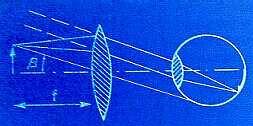
Lens quality in these magnifying glasses was often poor (due to chromatic aberration and airbubbles) so the images were not very clear. According to Pieter Harting a second loup could have been used to control the quality of the microscope lens during the grinding process. Cittert [REF:46] and others [REF:21] made the suggestion that van Leeuwenhoek could have grind or polish his lenses with the aid of very small pieces of glass [REF:21]. Others mentioned that he used abrasive powders [REF:50]. However also the method of glass-blowing (a method probably adopted from Robert Hooke and Johannes Hudde - 1624-1704- a scientist and lord mayor of Amsterdam) was used by van Leeuwenhoek to produce a small "spherical drop of glass" [REF:57]. In general, the quality of a light microscope (the objective or the lens) depends on many variables, such as: Numerical aperture (NA) : a measure of the ability to gather light and resolve fine specimen detail at a fixed object distance. Resolution (resolving power) (mm) : defined as the smallest distance between two points on a specimen that can still be distinguished as two separate entities. Resolution is a somewhat subjective value because at high magnification, an image may appear unsharp but still be resolved to the maximum ability of the objective. Numerical aperture determines the resolving power of an objective. The following formula by Ernst Abbeé (1840-1905) is used to establish the resolution-limit D of a lens  [n = Refraction-index (air, oil or water). Numerator = wavelength,lambda. Denomerator = NA = numerical aperture] The magnification of the simple microscope is defined by the formula: 
[M = magnification. f = focal distance of the lens, 250 = punctum proximum, accomodation point of the normal eye = ± 250 mm] We are well informed about the magnification power of the Leeuwenhoek microscope. See A.Schierbeek in Antoni van Leeuwenhoek, 1963,[REF:82 ] and Henry Baker [REF:80]. Due to his interest in the study of Natural History, van Leeuwenhoek started to grind lenses himself and constructed his own microscopes. His microscopes which he crafted himself by hand had powers of magnification ranging from 50X to [at least] 300 X and some of his ("sharp-sighted high quality") microscopes probably could reach magnifications of about 500 X. In several studies of the few remaining original (though used) microscopes this could be established and resolutions as good as 1 micron (1/1000 mm) could be distinguished,(the best instruments had a resolving power of about 1 micrometers or less. ). The focal distance of the lens in a van Leeuwenhoek microscope of superior quality should be < 1 mm [REF:34] - [REF:46]. According to calculations made by van A. Schierbeek [REF:82], based on Leeuwenhoek´s letter (12 nov.1680 to Robert Hooke, pp 57-60 ,see image below, published in the Dutch edition by Hendrik van Kroonevelt) the magnification of the van Leeuwenhoek´s microscope could reach 480x at least. Leeuwenhoeks´s
calculation of magnification [12 nov.1680 to Robert Hooke]. 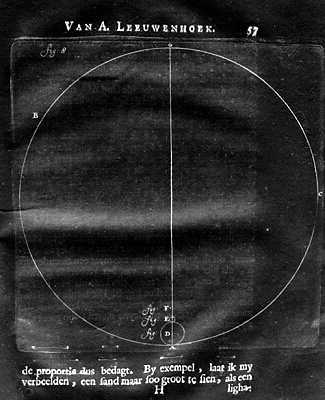 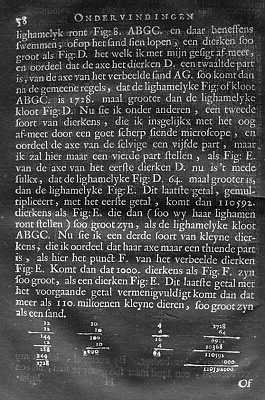 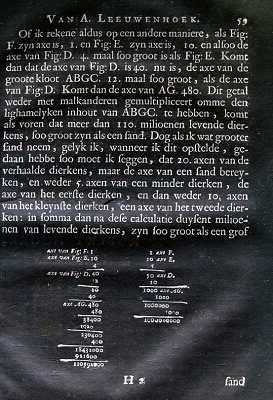 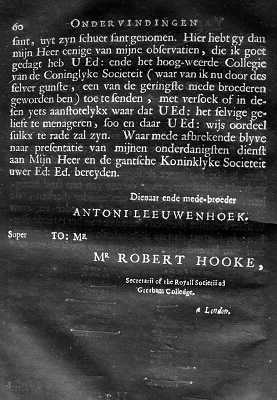 At L: An used Van Leeuwenhoek Microscope of normal quality [Dr. P.W. van Cittert,1943]  Antonie van Leeuwenhoek used single lens microscopes with extremely short focal lengths. This enabled him to see bacteria, the "little animals", spermcells and the very little globules (i.e. chloroplasts) in the green leaves for the first time in history. To oberve the objects with this simple microscope, the apparatus has to be placed closely before the eye in vertical position, against the light. He improved the resultant image by taking advantage of the optical principle that the least light distortion occurs close to the central ray. The lens was a double convex sphere, having a short focal length. When an object is placed nearer such a lens than its principal focus, i.e., within its focal length, an image is produced that is erect and larger than the object. The object to be examined was raised or lowered and rotated upon its axis by a coarse-threaded-screw. Meyer [REF:49] speculates that Leeuwenhoek's hand-held microscopes were only fit for demonstration purposes,and that for his researches, Leeuwenhoek used a compound microscope, which he kept secret and was lost after his death. To select the parts of his study-objects he was interested in, van
Leeuwenhoek first used a magnifying mirror, then he used a "common"
microscope or a magnifying-glass and if not satisfied, he took his "sharp-sighted"
microscope or "another way of observing, namely through a more
magnifying microscope" [Missive Sept.17th, 1683]. Most of his 500 microscopes were made of silver, gold or copper (or brass). His lenses were made of crystal, quartz of even (scratch resistent) diamond. He never published the way of how to make his lenses, so he carried this secret with him to the grave. The lens of the van Leeuwenhoek microscope is catched between two (copper,silver or brass) plates and and with a pinhole to hold a tiny drop of fluid. He did not make his drawings himself but he instructed his "Scriba" or "Tekenaer" (limner) carefully how to draw the things he observed and either approved or rejected those drawings. The identity of these limners is uncertain, though in a letter (april 4th, 1687, pages 7 - 15), van Leeuwenhoek gave the following information about his limner:
Then the engravings could be made on copperplates.At the moment only nine original microscopes have survived time (in musea or in private collection). Many times people have tried to imitate his microscopes. (Nowadays it is possible to make a replica of his microscope [REF:32]) Enhancing the quality of the microscopical objects. Antonie van Leeuwenhoek used a saffron-coloring procedure to enhance contrast in his objects. Furthermore, he sometimes filled a small glasstube with clean water containing living material and fixed the tube with the aid of two silver springs onto his microscope-plate. Probably this method caused some extra magnifying effect, due to the greater refraction-index of the water in the glasstube. When using a lens of diamond (refraction-index twice as large as water) the magnifying effect even could be more ! It is not clear how van Leeuwenhoek obtained the necessary illumination to achieve his remarkable results. The protozoologist Cecil Clifford Dobell (1886-1949) suggested that he might have discovered some simple method of dark-ground illumination, whereas Barnett Cohen pointed out that the optical properties of spherical drops of fluid containing the objects under observation may have been used by van Leeuwenhoek [REF:41].To investigate the same object, Antonie van Leeuwenhoek sometimes used several of his selfmade microscopes as well as magnifying glasses,"Vergrootglazen", and he not always used his own microscope. Occasionally he used a different microscope, possibly a sophisticated design made by Johan (or Johan Joosten) van Musschenbroek (1660-1707), a high power brass simple microscope with an adjustable fine focus [REF:87] , or a microscope constructed by Christian Huygens (1629-1695), [REF:14] as one can read in his "missives" from 1722. This microscope is the socalled "De Aalkijker" and van Leeuwenhoek used it to study the blood-circulatory system in the tail of an eel in a glass-tube (filled up with water or oil) (see image : "Aalkijker-microsope or Fishglass"). After a long series of experiments (starting from 1683 up to 1688) van Leeuwenhoek was the first to proof that the bloodcirculatory system was a closed system and that the pulsations were caused by the heart-rhythm.
[NOTE: Leonardo da Vinci (1452 - 1519) already studied the human circulatory system.] It is suggested that the fact that van Leeuwenhoek had close
relationships with textile merchants (as was his father in law) was not
insignificant. At that time the quality of textures was judged by
magnifying glasses. In contrast to the compound microscopes of Robert
Hooke and others the microscope of van Leeuwenhoek only had one single
lens and thus a minimum in optical aberrations. Due to this simplicity and
the high quality of the grinding procedure the van Leeuwenhoek microscopes
were the very best, until 1825. One could observe details up to 1 /1000-th
millimeters (1 micron). Only after 1825 the compound microscope has
overtook its disadvantage by corrections on the objectives and a better
illumination system. A lunar crater (Leeuwenhoek Lunar crater,
position 29.3S and 178.7W, 125 km diameter) is named after him [ Leeuwenhoek
crater]. |
Generatio Spontane
|
|
Van Leeuwenhoek was a creationist (everything exsists by the creation
of God) and (lucky for modern Science !) he disputed the general
Aristotelian view of his time that living organisms could be spontaneously
generated. Louis Pasteur [24] quotes these passages in his work (1862). |
|
Missive 75, 16 sept 1692:"Studying the reproduction of Eel, Delft in Holland den 26.September 1692 |
Concept of FertilizationOvists, Spermists and "the first essential material" of Van Leeuwenhoek.
|
|
Antonie van Leeuwenhoek´s first description of microbes: Van Leeuwenhoek was the first to describe a number of microscopic
aquatic life forms (Euglenids, Protozoa, Rotifers [REF:53],
Foraminafera and others). He wrote: "We can easily conceive that in all
rainwater which is collected from gutters and in all waters exposed to the
air, animals may be found, for they may be carried thither by the
particles of dust blown about by the winds." In his letter of sept.7th, 1674 van Leeuwenhoek gives an accurate description of microbes for the first time in history. When sailing on a boat in "het Berkelse Meer" he filled a bottle with water from the lake of Berkel and next day he observed it through his microscope, writing as follows: "Passing just lately over this lake, . . . and examining this water next day, I found floating therein divers earthy particles, and some green streaks, spirally wound serpent-wise, and orderly arranged, after the manner of the copper or tin worms, which distillers use to cool their liquors as they distil over. The whole circumference of each of these streaks was about the thickness of a hair of one's head. . . all consisted of very small green globules joined together: and there were very many small green globules as well." Here he describes the green charophyte alga Spirogyra a protozoa. In a letter of 1675 and a letter December 25th, 1702, he gives descriptions of Coelenterata and other protists, including a swimming bellshaped Ciliate, Vorticella (Dutch" ´t Klokkedyr") in rain-water, Hydra (the freshwater polyp), Volvox and Rotifers (Acoelomata, "Wheel animals" or "Radardiertjens").
Henry Baker´s observation of the Rotifers (1756)
|
|
First image of Bacteria. This image is
protected. 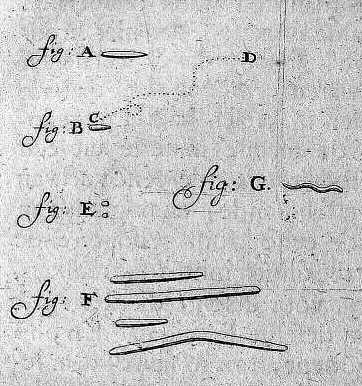 Dotted line between C and D indicates motility. Compare "Current Protocols In Microbiology Vol. I, John Wiley & Sons, Inc. USA, (2006), ISBN 0-471-72924-8", Cover. Wiley |
|
Van Leeuwenhoek´s famous
description of microbes in tooth plaque (First edition, Delft in Holland,
12 September 1683, to Francois Aston, Pag.11). Leeuwenhoek´s drawing of
short rods of bacilli and bacteria, the spheres of micrococci, and the
corkscrew spirillum. (1B. In DUTCH) (1A. In ENGLISH) Actually he estimated more bacteria in one single drop than the number of inhabitants living in the Dutch Republic at that moment. He also observed that Vinegar and Alcohol could kill some bacteria in the mouth.
Evert Valk (in the year 1744, above mentioned) recognized and emphasized the importance of the observations of van Leeuwenhoek and he quotes the work of "Leeuwenhoek, De Vermaarde Man" (Leeuwenhoek, the Famous Man) in his publication " GENEES KUNDIG VERHAAL VAN DE ALGEMENE IN ZWANG GEGAAN HEBBENDE LOOP-ZIEKTE... ". Evert Valk quotes van Leeuwenhoek (the missives 43, 59, 71, 75):
Either Microorganism
(cocci) or scales of the human skin,Fig.H)
Protozoa and bacteria eating dead freshwater mussels ("ongeboore Veen-Moffelen, Veen-oesters") and small shell-fishes ("Schulp-viskens, schulp-dierkens") and playing a role in the purification of water.  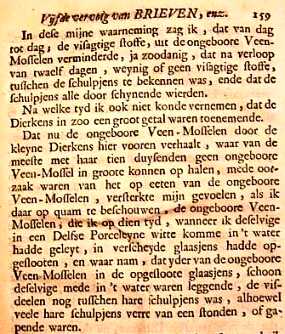 In his missive nr. 96 to the elector of the Palatine (of the Rhine) Antonie van Leeuwenhoek reported that animalcules, both protozoa (rotating and motile animalcules with stalks and "clustered like grapes") and bacteria, were playing a part in the decomposition of dead mussels in the canals and fens of Holland - an early intimation of biological purification and recycling. Van Leeuwenhoek also observed that Rotifers could live in colonies and survived desiccation in the form of resting eggs, or cysts, reanimating within 24 hours of coming into contact with water. Size-estimation of
Infusoria
Yeast Globules In MISSIVE June 14th, 1680 to Thomas Gale, Antonie van
Leeuwenhoek describes "YEAST (GIST)"
A Quasi Experimental Approach. In the same letter of 1680 in which van Leeuwenhoek described the process of Beer-making and Yeast globules, he described (pages 7-10) one of the most remarkable experiments of his total Works (at least it appeares so to me, WAWM). On these pages he asked himself (1.) what the cause could be of airbubbles (LUGT-BELLETGENS) in beer and other materials, embedded in liquid, and (2.) ... "if it is true that no living creature could exist in a closed bottle". One should notice the modern style, perfectly formulated to falsificate a Null-hypothesis. Here the reader can take cognizance of his scientific approach as a pure researcher : "Hiervan heb ik mede eenige preuven willen nemen, hebbende dan genomen twee glase tuben ABCDEFGHIKL.die na deselvige beyde onderaan AL waren toegemaakt ..."(see drawing on page 8). Two Glass tubes,one sealed,one in contact with the open air
Proving a hypothesis about the earth-movement.
Leeuwenhoek
was the first to observe the constituents of
blood.
Vascular system in lobated Braintissue of the pig Antonie van Leeuwenhoek
proved that venes and arteries are connected by capillary vessels (below,
Fig.9). He calculated that the skin of an adult contains 2016000000
capillaries and that the heart makes 31536000 pulsations a
year!
Model of the closed bloodcirculatory system. Missive nr.67, April
1st, 1689,Delft. Explaining this model (see image, fig.1), van Leeuwenhoek refers to the
force on a fluid in a watercolumn described by the Dutch physicist and
mathematician Simon
Stevin(1548-1620), in "Beghinselen des
Waterwichts".
Photo-negative.Branches of the vascular system, observed in the wing
of a night-moth (Noctuidae, "Uyltje"). Missive 73. Delft June 24, 1692 to
the Royal Society.
Transversal cut through the nerves of the Spinal Marrow of the
Lamb.
Human Molar-tooth (Missive April 4th, 1687)
Muscle fibers of a cow.
"About 9-times smaller than my beard, containing about 5000 small
musclefibers / Inch2"(Delft 3 March,1682 to Robert Hooke).
Mosquito (Culex pipiens), larva and Snout-beetles (below) Missive 64. Delft aug.24,1688: Biting mouth parts of the Mosquito (according to van Leeuwenhoek the "stinging" parts are depicted after Jan Swammerdam). "...Die ik den tekenaer naar het leven heb laten aftekenen..." - "Which I let the limner draw this from the life .." On (at least) four different locations in his works, van Leeuwenhoek gives a description of (male and female) mosquito´s : an early Missive (Jan.22, 1683 AD) directed to Christopher Wren, Missive 64 and Missive 77 (1688 AD) and the socalled missive XII (1713 AD), directed to the Royal Society. In fact he gives a description of three different species that could be found during his lifetime in the Lower Countries. Since Robert Koch (1882) mosquito´s are well-known as a vectorborne transmitter of diseases (malaria,yellow fever).
Green plant louse (probably Aphis ribes L) observed on the Ribes red-currant. The louse is placed on his back onto the apex of a needle (see fig. EDUT). Missive 90, Delft july 10th,1695 to Frederik Adriaan, Baron. At position B van Leeuwenhoek saw a little drop of liquid that works "like a second magnifying glass because objects like houses and towers, can be observed upside down". Further he decribed the metamorphosis of the louse and Ants that "eat the louses" in wintertime. East Indian Centiped ("Duyzentbeen"), "Socalled burned paper fallen from heaven" (heavenly paper = dried Alga material or Scenedesmus) "Vlijm", Stinging Nettle, Amber [REF:4].
Insect "Flying creature
with hardened redish-brown wing-shells" with larva,probably the
Capricorn beetle.
Corn Weevil. Insect
Coleoptera: Curculionidae: Sitophilus zeamais
Motschulsky Leeuwenhoek´s observations of corn weevils (maize weevils) mating helped to disprove the theory of abiogenesis. Before this discovery, people thought that the weevils were spontaneously generated from the grain itself and not from eggs. He also observed and described the life cycles of other animals [once thought to have been spontaneously generated out of materials such as mud and decaying matter].
Different life stadia of the Ant
Silk-worm and Cocoon
Wood-worm
TOP
TOP Filtersystem of Mussels (Molluscae)
The scales of the Eel Antonie van Leeuwenhoek observed that,in contrast to the general opinion, the skin of an EEL is covered with scales, and refers to the commandment in Deuteronomy and Leviticus to the Jews not to eat fishes that do not have fins and scales ["geen vinnen en schobben", see microsopic view of the scale-structure at fig. 1 and eye-view at fig.2, Deuteronomy 14;10 and Leviticus 11;12].
Tadpole - Frog metamorphosis Missive 65. 7 september 1688 Missive nr. 65: Van
leeuwenhoek describes the metamorphosis of the frogs (tadpoles,
"kikvorschen" or "worken") from the egg (etching fig. 1 upper left
corner). Van Leeuwenhoek wrote: "The fact that Harveus or Swammerdam
did not see a head will be clear, because they did not use a magnifying
glass"!
Missive nr 65 Swammerdam and Harvey (Harveus), dealing about the Tadpole
Fluke, a parasite in the liver, Fasciola hepatica or "Leverbot" (by some others abusively called Planaria, a type of flatworm)
Bird´s feather (Veer)
Hair of a pig, cross section (1681)
Annual-rings and the
structue of Wood (Northern-European and Tropical Trees)
Different stadia of the
Nutmeg (Myristica fragrans), Missive 88, May Ist,1695,"Van de
Noote-Muscaat" to Antoni Heinsius,Raat Pensionaris van Holland,
&c"
Coffeeplant: Beans, Germ and Cellular-tissue
Wheat germ
Missive to Herman Boerhave, Sept. 28th, 1716 Parts of a broken Coconut from Curacao "Kurasschouw": The seed,the freshly coconut meat and structural-details.
Crystals- in
Wine-Vinegar (A..H) and the Vinegar-eel (LM-NO). (Most likely at D: yeastcells.)
Pareira bravea, Curare TOP
"The last Missives"
|

|
Famous visitors at van Leeuwenhoek´s home During 50 years
van Leeuwenhoek wrote his letters (in Dutch), to the Royal Society in
Londen as a member since 1679. Robert Hooke and
Hendrik Oldenburg were the secretaries.
Numerous famous and historical personages visited his works at his home :
amoung these Christiaan Huygens, Boerhave, Heinsius,
Descartes, Leibnitz (staying at Spinoza´s home at The Hague), Spinoza,
Christopher Wren, Tsar Peter the Great who sailed on the "Delftse
Schie" in good company with Antonie van Leeuwenhoek himself, Queen
Mary (Mary Stuart II, wife of William III of
Orange) and Queen An of Great Brittain,the prince of Lichtenstein
and Frederik the Great.
He dedicated a missive from 1717 to the Emperor
Charles of Spain who could not visit van Leeuwenhoek due to a
strong Eastern Storm. Another Monarch of that time-period who never
visited van Antonie van Leeuwenhoek was Louis XIV, the envious "sun-king",
plagued with various parasites, due to poor hygiene. |

Letters (Missives or Sentbrieven) by Antonie van Leeuwenhoek
|

The year 1632
|
| " 1 Febr. 1678, compareert Anthonij Leeuwenhoeck, te Delft, als bij de Heeren Scheepenen der stadt Delft, gestelde curateur over den insolventen en gerepudieerden boedel en goederen van Catharina Bolnes,Wed. en boedelhoudster geweest van wijlen Johanes Vermeer,in sijn leven schilder binner desert Stadt en verclaerde machtich te maeken.." |
The Geographer (Leeuwenhoek, "possibly as a Model" in Vermeer´s Painting)
 |
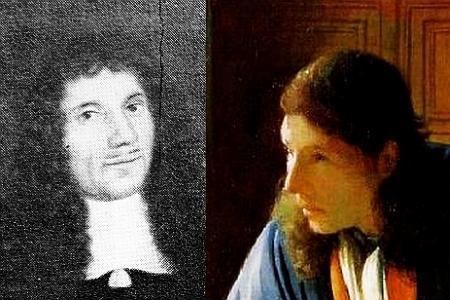
Left: A.Van Leeuwenhoek, after a painting by Cornelis de Man (1621 - 1706), van het Gilde der Medici, 1681, Delft. Right:The Geographer by Johannes Vermeer, 1669. |
In November 24,1632 exactly four weeks after the birth of van Leeuwenhoek and Vermeer, Baruch (Benedict) de Spinoza, a great admirer of van Leeuwenhoek, was born in Amsterdam. Spinoza, living at Amsterdam up to 1666, learned how to grind lenses in 1656, the year he was banished from the Synagogue. He was a great philosopher and a well-known lense-grinder too, and there must be some exchanges in knowledge about optics between them [REF:52].
In 1632, Rembrandt Harmenszoon van Rijn painted "Doctor Nicolaes Tulp's Demonstration of the Anatomy of the Arm" and "The Raising of Lazarus" (etch).
In 1632 Frederik Hendrik, Prince of Orange, nicknamed "the fortress compeller (stedendwinger)", defeated the Spanish at Maastricht (eighty-years War) and from that time on a period of wealth, stability and religious toleration started in The Netherlands.
In 1632 the Durch Reformed Church and the Athenaeum Illustre (precursor of the University of Amsterdam) were founded.
In 1632 the United Dutch East Indian Company (VOC) reached maximum worldpower.In 1632 Galileo Gallilei published his most important work,
"Dialogo sopra i due sistemi del mondo" ,
(´Samenspraak over de twee wereldstelsels').
[Free-fall with uniform
acceleration: It is worth noting that Simon
Stevin observed that objects having different masses all
underwent equal (uniform) fall-acceleration, three years before
Galileo Galilei published his concept of the Heliocentric World, [REF
64].
On August 1632, John Locke was born at Wrington, a
village in Somerset.
1632, the third wave of the Bubonic
Plague (Black Death) reaches
Europe.
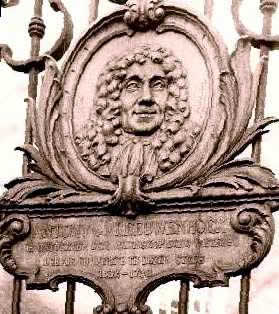

Antoni van Leeuwenhoek: perhaps he was an amateur in Science, but his perceptive faculty and his honesty was unsurpassable.
|
[1] History of the Light Microscope,1995, 1997 Thomas E. Jones. [3] Antonie van Leeuwenhoek:Detailed Biography by Top Telemedia Ltd., India Biographies,2002 [6] Antonie van Leeuwenhoek Spermatozoa.E. G. Ruestow, J. History of Biology 16: 185-224. [8] University of California Museum of Paleontology [9] Botany on line Microscopy English edition. Peter v. Sengbusch,2002 [10] Botany on line Microscopy German edition. Peter v. Sengbusch,2002 [11] Biography Antonio van Leeuwenhoek. Whonamedit.com Biographical dictionary of medical eponyms [16] Antonie van Leeuwenhoek "Ontdeckte onsichtbaarheeden", Original Bands 1685-1717 (Leyden and Delft). [17]C. Dobell,Clifford "Anthony van Leeuwenhoek and his "Little Animals", (London: Staples Press, 1932). Dobbell, Clifford: Antony van Leeuwenhoek and his little animals, 1958, Nw York Russel & Russell Inc. ibrary of Congress Catalog Card no. 58-7087 [18]A. Schierbeek, Antoni van Leeuwenhoek. "Zijn leven en zijn werken", 2 vols. (Lochem, 1950-51). [19] Prof. Dr. A. Charlotte Ruys (1957),"Leerboek der microbiologie en immunologie", NV Oosthoek Utrecht. [20] A. Schierbeek, Measuring the Invisible World. " The Life and Works of Antoni van Leeuwenhoek" FRS, (London, 1959). [21] Gerald L´Estrange Turner (1981), "Historische microscopen", Studio Vista (Cassell ltd),London,Christies Collections. [22] Kluwer : Antonie Van Leeuwenhoek; Journal of Microbiology and Serology [23] P.Smit on page 9-23, De Ontdekking van de "Kleijne diertgens" in F.Wensinck (1976) "De microbiologie drie eeuwen na Antonie van Leeuwenhoek", Centrum voor Landbouwpublicaties en landbouwdocumentatie",Ed. Pudoc, Wageningen. [24] L.Pasteur, (1862) "Die in der Atmosphare vorhandenen organisirten Korperchen,Prufung der Lehre der Urzeugung" in Annales de Chimie et de Physique, 3.Serie Bd . LXIV. [25] Pelletier, P. J. and Caventou, J. B. (1818). Ann. Chim. et Phys. 9: 194-196. See also in : "What does the green mean ?" [26] Watson and Crick described the structure of DNA in 1953. [27] Jeff Miller: UCSF Research Philosophy Of Science, Scientists and UCSF, October 22, 2001. [29] Abraham Bredius: "Iets over Johannes Vermeer",Oud Holland, 3. page 217 (1885).The Art Collection of the Bredius Museum, The Hague. [30] Hajo Dutching "Jan Vermeer van Delft" Rebo productions, Ed. Koninklijke Smeets Offset, bv. Weert, (1996). [31] Website: Willem and Thomas van de Wilt http://www.xs4all.nl/~kalden/dart/d-a-verkolje.htm [32] Website: Allan Shin:To Make a Van Leeuwenhoek Microscope Replica http://www.mindspring.com/~alshinn/Leeuwenhoekplans.html [33] Website: W.A.W. Moll, Electron Microscope and Cellbiology : studies on Chloroplast-membranes (2002) http://www.euronet.nl/users/warnar/chloroplast.html [34] Cittert, P.H. van. "Descriptive catalogue of the collection of microscopes in charge of the Utrecht University Museum", Noordhoff, Groningen (1934). [35] Bjorn Uwe Kambeck, Antique microscopes and other scientific instruments and books, 2002 [36] Interactive Historical Timelines: Who What When :Historical Timelines, SBROWNING.COM [37] Prof.dr. J.C. van Lenteren: Did Antonie van Leeuwenhoek discover insect parasitism ?ANTONIE VAN LEEUWENHOEK SYMPOSIUM, 1- 6 October 2000, Haarlem, The Netherlands. [38] Groen van Prinsterer, G. "Handboek der Geschiedenis van het Vaderland" (van Leeuwenhoek, uitvinder van de mikroskoop). Ed. H. Höveker, Amsterdam (1852), pag 382. [39] Spectacles: Mr. C.N.Chua BMed Sci. MRCP FRCOphth Oxford Eye HospitalOphtalmology [40] A brief
history of toxins(2002). Alistair Lax King's College London [41] Antonie van
Leeuwenhoek, Microscopical observations. The Educational Broadcasting
Corporation (2002). [42] The Slow
Death of the Spontaneous Generation. The National Health Museum
(2002).BIOTECH [43] THE WORLD’S
GREATEST CREATION SCIENTISTS,David F. Coppedge (2002) [44] Van
Hogenhouck Genealogy [45] Pieter
Harting. "De nieuwste verbeteringen van het MIKROSKOOP en zijn gebruik,
sedert 1850". H.C.A.Campagne,Ed. Tiel, 1858. [46] Dr. P.W.
van Cittert "Het Microscoop", J.Noorduijn en zoon, N.V., Gorinchem
1943,Nederland. Noorduijn´s Wetenschappelijke Reeks. [47] Virtuellen
Museum der Wissenschaft :Vortrag Kurt Paulus "Das
Mikroskop Werkzeug des Lebenswissenschaftlers", Berlin 2001 [48] Jan van der
Stroom "Life is wonderful",
http://www.geocities.com/levensverhaal/index.html [49] MEYER,
Klaus, Geheimnisse des Antoni van Leeuwenhoek. Ein Beitrag zur
Frühgeschichte der Mikroskopie (Lengerich etc., Pabst Science Publishers,
1998). 647 pages. ISBN 3-931660-89-3.
See web site: Mathias Orgeldinger. Vorreiter der wissenschaftlichen
Mikroskopie (2000). [50] Giorgio Carboni,
(1996): A GLASS-SPHERE MICROSCOPE [51] Zanot
Science Lessons : Studying Cells Tutorial [52] "Cells of Spinoza": Tetsuro
Onuma, Representative of Yone Production Co.Ltd. (2002) [53] World of
Rotifers:Richard L. Howey and Wim van Egmond (1999-2002) [54] Blok, P.J. "Geschiedenis van het Nederlandsche Volk",
part V. Ed J.B.Wolters, Groningen , 1902 [55] Kaldenbach Website : Leeuwenhoek
Signature [56] KNAW : Royal Netherlands Academy of
Arts and Sciences [57] Palm, L.C. Antonie van Leeuwenhoek (1632-1723), De
onsigbare geschapene waarheden, in:Van Stevin tot Lorentz, Intermmediaire
Bibliotheek, A.J.Kox, M.Cjamalaun, Eds,(1980), ISBN: 90 6434009
9 [58] Hooykaas, R. 'Science and Religion in the 17th Century:
Isaac Beeckman (1588-1637).' Free University Quarterly [Amsterdam] 1
(1951): 169-183. [59] The Galileo Project Development Team.
Richard S. Westfall Department of History and Philosophy of
Science [60] E.J.Dijksterhuis, ("The Mechanization of the World
Picture: Pythagoras to Newton"), De mechanisering van het Wereldbeeld,Ed.
Meulenhoff, Amsterdam, (1950), ISBN 90 290 0330 8 [61] Bertrand Russel, ("History of Western Philosophy"),
Geschiedenis der Westerse Filosofie. Ed. Servire BV Katwijk aan Zee,
(1948), ISBN 90 6077 307 1 [62] Christiaan Huygens Huygens:
the greatest mechanist of the seventeenth century [65] Peter
Highes 2002: About Michael Servetus (1509 or 1511-1553)
[67] Konemann
Verslaggesellschaft mbH,2000:"Islam Kunst und Architektur" (ISLAM,Art and
Architecture), ISBN 3-8290-2557-2 [68] Source:
Catalog Files Website Galileo Project: Desciption Antonie van
Leeuwenhoek. [70] UBA: De
Nederlandse Leeuw. Een gids voor biografische gegevens van Nederlanders :
Universiteitsbibliotheek, Singel 425, Amsterdam (Biographic data,
Library of the University of Amsterdam) [71] Description of Cornelis Drebbel in: Jacques Alexandre de Chalmot (1734-1801), "Biographisch Woordenboek der Nederlanden", Vol.VIII, pp 348-351,Ed. Johannes Allart, 1798-1800, Amsterdam [extremely rare book]. [72] Leeuwenhoek's
Perception of the Spermatozoa: E. G. Ruestow, J. History of Biology 16:
185-224. [80] Henri Baker: "Nuttig gebruik van het Mikroskoop". Lid van de Koninklijke Societeit en het genootschap van Oudheid onderzoekers te Leiden. ED: F.Houttuyn, Amsterdam, 1756. [81] Jan Mol and the first van Leeuwenhoek film in :Biographisch
Woordenboek van Nederland, Vol.V, 2001, page 351-353, Instituut voor
Nederlandse Geschiedenis,Den Haag. [82] A.Schierbeek, "Antonie van leeuwenhoek",ED. Kruseman Den Haag, 1963.
[85] NASA ASYTROBIOLOGICAL INSTITUTE, Archive 2003 [86] The Christiaan Huygens WEB :http://www.phys.uu.nl/~huygens/ [87] The Musschenbroek microscope, Virtual Museum
[90] WIKIPEDIA, Charles Darwin http://nl.wikipedia.org/wiki/Charles_Darwin [91] Institute for History and Foundations of Mathematical and the Natural Sciences, Utrecht[92] Library TU Delft. Tresor. Elektronic Versions of the "Send brieven" of Antonie van Leeuwenhoek Scientific Collections: Dr. W.A.W.Moll, University of Amsterdam,The Netherlands.
REQUESTS for publication
DISCLAIMER.
E-mail to me:wawmoll@lycos.com |